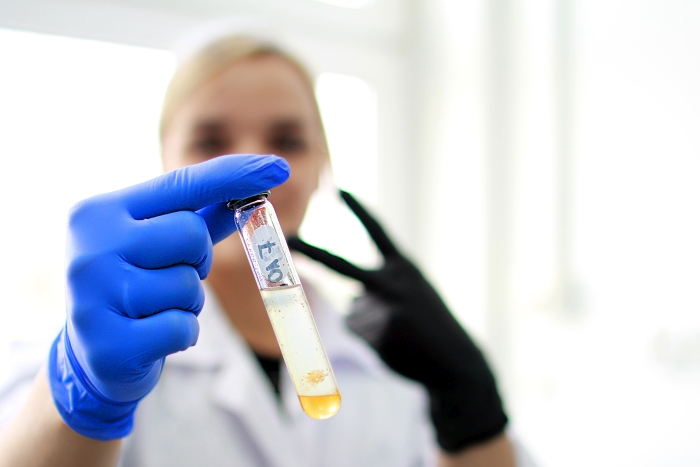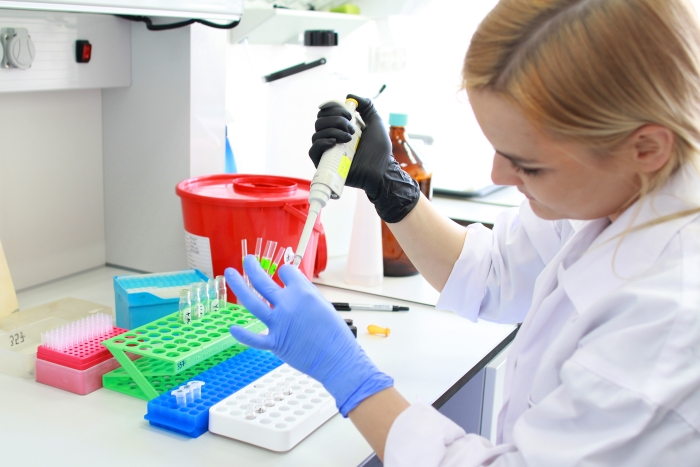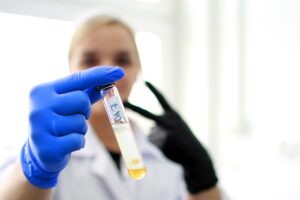The group works on the investigation of the mechanisms of bacterial pathogenicity and the role of bacterial and phages surface antigens including glycoconjugates and bacterial proteins in the immune response.
Area of interest:
- biochemical markers of infectious inflammatory processes, sepsis and septic shock in rapid diagnostics and disease monitoring
- epidemiology, prevention and diagnosis of nocardiosis, tuberculosis and actinomycosis-like diseases with the use of glycolipids and polysaccharides and instrumental methods
- advanced glycation processes and their participation in the immune response, determination of advanced glycation end-products (AGEs) in biological material
- structural and serological studies of bacterial and phage surface antigens and the role of these antigens in the development of diseases and the immune response
- conjugate vaccine carriers, adjuvants and markers of immunodeficiencies
- bacteriophage antigens as a tool for monitoring anti-phage antibodies in human serum and as diagnostic markers
- structure and functions of probiotic surface antigens
- micromechanical sensors for the detection of endotoxins and microorganisms
- new classes of fluorescent particles in biological tests, investigation of already described proteins as new diagnostic markers
Prof. dr hab. Andrzej Gamian (orcid.org/0000-0002-2206-6591)
 Prof. Gamian graduated from the Faculty of Natural Sciences at the University of Wroclaw in 1975 and he started to work at the Hirszfeld Institute of Immunology and Experimental Therapy, PAS where he carried out his doctoral studies on the immunochemistry of Shigella lipopolysaccharides and obtained his PhD in 1982. Between 1984-86 he joined a research group at the National Research Council of Canada in Ottawa, where he was working on the development of anti-meningococcal B meningitis vaccine. In 1990 he was a scholar at the CNRS in Grenoble, France, working on the structure of the sugar part of the endotoxins. He was also involved in the research on bacterial antigens at the Arrhenius Laboratory in Stockholm and Uppsala.
Prof. Gamian graduated from the Faculty of Natural Sciences at the University of Wroclaw in 1975 and he started to work at the Hirszfeld Institute of Immunology and Experimental Therapy, PAS where he carried out his doctoral studies on the immunochemistry of Shigella lipopolysaccharides and obtained his PhD in 1982. Between 1984-86 he joined a research group at the National Research Council of Canada in Ottawa, where he was working on the development of anti-meningococcal B meningitis vaccine. In 1990 he was a scholar at the CNRS in Grenoble, France, working on the structure of the sugar part of the endotoxins. He was also involved in the research on bacterial antigens at the Arrhenius Laboratory in Stockholm and Uppsala.
In 1993 he received his habilitation for the work on the Enterobacteriaceae lipopolysaccharides containing sialic acid, and ten years later was nominated full professor by the President of the Republic of Poland. Since 1994 has been the head of the Department of Immunology of Infectious Diseases, HIIET PAS. Between 2006-2020 he was also the head of the Department of Medical Biochemistry, Medical University in Wroclaw. Since July 2020 has been the Director of the HIIET, PAS in Wroclaw.
He has co-authored over 380 scientific publications and is the owner of 50 patents and patent applications. His scientific interests focus mainly on the study of polysaccharides immunochemistry, the study of glycolipids, microbial proteins and phages, and their utility in diagnostics, antiviral and antibacterial vaccine design and clinical therapy. His greatest scientific interests are focused on the issue of protein glycation and the consequences of AGEs aggregation in the body. In addition, his expertise includes methods of determining disease markers, especially metabolic, vascular and neurodegenerative diseases.
Secretary:
- Joanna Ziółkowska MSc
Associate Professors:
- Danuta Witkowska, PhD, DSc, (orcid.org/0000-0003-3494-8724)
- Mariola Paściak, PhD, DSc, (orcid.org/0000-0002-2603-4634)
- Jacek Rybka, PhD, DSc, (orcid.org/0000-0003-4499-1574)
- Bogumiła Szponar, PhD, DSc, (orcid.org/0000-0002-9111-2328)
Assistant Professors:
- Ewa Brzozowska, PhD, DSc, (orcid.org/0000-0003-0922-3625)
- Agnieszka Korzeniowska-Kowal, PhD, (orcid.org/0000-0001-7569-8018)
- Anna Jarząb, PhD, (orcid.org/0000-0002-1059-9147)
- Eva Krzyżewska-Dudek, PhD, (orcid.org/0000-0002-5581-1690)
- Karolina Filik-Matyjaszczyk, PhD, (orcid.org/0000-0002-8086-038X)
Research Assistant:
- Weronika Jasińska, PhD, (orcid.org/0000-0003-3989-8041)
Specialists:
- Marek Drab, PhD, DSc, – chief specialist for environmental research equipment (orcid.org/0000-0002-2771-1692)
- Katarzyna Kapczyńska, PhD, – chief specialist for environmental research equipment (orcid.org/0000-0003-2722-9596)
- Gabriela Cieniuch-Speruda, PhD, – microbiology specialist (orcid.org/0000-0002-8706-364X)
- Anna Chudzik, PhD, – biotechnology specialist (orcid.org/0000-0003-2789-8300)
- Anna Wzorek, MSc, – chief specialist for microbiology (orcid.org/0000-0002-1437-4447)
- Kamila Szecówka, MSc, – biology specialist (orcid.org/0009-0001-2978-1301)
- Karina Krasna, MSc Eng, – biotechnology specialist (orcid.org/0009-0006-6888-2814)
- Marzena Ciesielska, MSc, – biology specialist (orcid.org/0000-0002-3076-1885)
- Patrycja Bochen, MSc Eng, – biotechnology specialist (orcid.org/0000-0002-3530-1263)
- Eng Katarzyna Bzowa – biotechnology specialist
Technicians:
- Wojciech Rybka
- Bernardeta Szostko
PhD Students:
- Magdalena Geneja-Maciejewska, MSc Eng, (orcid.org/0000-0002-9765-3977)
- Roksana Kruszakin, MSc, (orcid.org/0000-0002-4268-934X)
- Katarzyna Machnik, MSc, (orcid.org/0009-0005-3496-5956)
- Jakub Smoliński, MSc Eng, (orcid.org/0000-0001-7280-7194)
- Jan Brykała, MSc, (orcid.org/0009-0003-1152-1223)
- Determination of a new epitope representing an advanced glycation end-product in the human body and the development of diagnostic test to detect the antigen in serum under health and metabolic disorder in Alzheimer’s disease (2001-2021).
- The phenomenon of water polarization caused by phonon resonance has been described (2021).
- Determination of the antibacterial protective epitopes:
- the phenomenon of post-translational glycylation of the polysaccharides was described, the presence of glycine in the core part of endotoxins constituting a common epitope was demonstrated (1981-2011)
- it was discovered that protective antibodies with broad anti-enterobacterial activity present in umbilical cord blood recognize a hexa-peptide epitope of the OmpC protein, a diagnostic test for determining humoral immunological deficiencies was developed (2005-2021)
- A new type of glycosylation of sialic acid at the C-7 position was described (1984-1993); structures of bacterial polysaccharides with sialic acid were determined, it was shown that antibodies recognizing such polysaccharides structures detect also human glandular epithelium and nervous tissue and are present on the tumor tissues derived from them (1993-2015).
- determination of endotoxins
- tests for determination of advanced glycation end-products (AGEs)
- glycobiological methods for determining the structure of glycoconjugates
- synthesis in a microwave reactor
- epitope determination by solid phase peptide synthesis and bioinformatics
- biological molecules conjugation (peptides, proteins)
- immunoenzymatic (ELISA, cell-ELISA, Western-blot, immunodiffusion, immunoprecipitation, passive hemaglutination)
- chromatography: gel filtration (GF), ion-exchange (IEX), affinity (AC), hydrophobic interaction (HIC) in systems: FPLC, HPLC
- multiplex cytokine assay
- proteomics (protein/proteomes identification)
- cell culture (viability, migration/invasion tests)
- hybridoma technologies, preparation of monoclonal antibodies
- microbiological techniques – actinobacterial methods
- bacteria cell culture (preservation, storage, dyeing, identification, viability tests, bacterial antigen extraction and purification)
- bacteriophage techniques (phage purification, storage, antigen purification)
- characteristics of glycoconjugates
- bactericidal activity
- opsonophagocytosis test
- Microwave reactor
- LAL laboratory
- cell culture facility (equipped with CO2 incubator, light microscopes, and laminar flow benches)
- microbiological laboratory (equipped with bacterial incubator, light microscopes, and laminar flow benches)
- radioisotope facility
- PCR cycler
- Nano-drop
- MALDI-TOF-MS Biotyper
- gas-liquid chromatograph with ITQ-MS mass spectrometer
- Research project of the National Center for Research and Development under the Leader XIII Program (0093/L-13/2022): “Development of an innovative peptide vaccine protecting against bacterial dysentery”. Project leader: dr. Anna Jarząb.
- Research project of the National Center for Research and Development as part of the project “Support for single-name hospitals in the fight against the spread of SARS-CoV-2 infection and in the treatment of COVID-19” (October 2020-October 2021): Research on obtaining an innovative vaccine against the SARS-CoV virus -2 responsible for the COVID-19 disease. Consortium with the Gromkowski Provincial Specialist Hospital in Wrocław. Project leader: prof. dr. hab. Andrzej Gamian.
- Research project of the National Center for Research and Development TANGO-IV-A/0003/2019-00 (2020-2021): Innovative medicinal product against Clostridioides difficile based on IgY antibodies. Project leader: prof. dr hab. Andrzej Gamian (co-investigators: Sabina Górska, PhD, Agnieszka Razim, PhD, Katarzyna Pacyga, MSc)
- Research project of the National Science Center SONATA BIS 7 No. 2017/26/E/NZ1/00249 (May 18, 2018-May 17, 2022): Bi-functional bacteriophage tail proteins – determination of the function and mechanism of action against (poly)saccharide substrates. Project leader: dr. hab. Ewa Brzozowska.
- Research project NCN OPUS 11 No. 2016/21/B/NZ6/02286 (February 17, 2017-February 16, 2021): Epitope mapping of Clostridium difficile surface proteins and characterization of the protective properties of the epitope carrier protein conjugate in combination with a modern nanoadjuvant. Project leader: prof. dr. hab. Andrzej Gamian.
- Research project of the National Science Center OPUS 11 No. 2016/21/B/NZ6/02028 (10.05.2017-09.05.2020): Study of glycolipids from Porphyromonas gingivalis reconstructed in E. coli as the basis of a new vaccine against periodontitis. Project leader: Dr. Wiesław Świętnicki.
- EU project: European Cooperation in Science and Technology COST: “ENOVA – European Network of Vaccine Adjuvants” (2016-2021). Prof. dr. hab. Andrzej Gamian – National member of the Management Committee.
- Research project of the National Science Center SONATA 2 No. 2011/03/D/NZ7/02054 (07.12.2012-06.12.2017): Study of the use of phage adhesins in the detection of bacterial environmental contamination with the use of modern optical fiber sensors. Project leader: dr. hab. Ewa Brzozowska (project co-investigator: Dr. Sabina Górska).
- Key project (POIG 01.01.02-02-003/08-00): BioMed – Biotechnologies and advanced medical technologies (2009-2015), Task 3.4: “Diagnosis and prevention of bacterial diseases”. Contracting authority: JRC EIT+ in Wroclaw. Implementing institution: Consortium of the Institute of Immunology and Experimental Therapy of the Polish Academy of Sciences (leader) and the Medical University in Wrocław. Project leader: prof. Dr. Andrzej Gamian (co-investigators: dr. Danuta Witkowska, dr. Anna Jarząb, dr. Sabina Górska, dr. Ewa Brzozowska, dr. Mariola Paściak, dr. Jacek Rybka, dr. Agnieszka Korzeniowska-Kowal).
- Project co-financed by the European Regional Development Fund under the Cross-border Cooperation Operational Program – Czech Republic and Republic of Poland (project no. CZ.3.22/2.1.00/09.01574) (2007-2013): Probiotics: scientific cooperation, knowledge transfer and education. Leading partner: Mikrobiologický Ústav AV ČR, v.v.i. (Institute of Microbiology of the Czech Academy of Sciences, public research institute), Prague; Project partner: Institute of Immunology and Experimental Therapy of the Polish Academy of Sciences (01/08/2010 – 30/09/2013). Project leader at IITD PAN: prof. dr. hab. Andrzej Gamian (co-investigators: dr. Sabina Górska, dr. Jacek Rybka).
- Research project POIG.02.03.02-00-005/10 (October 1, 2010-September 30, 2014), co-financed from EU funds under POIG for 2007-2013, Priority II, Measure 2.3, Sub-measure 2.3.2. Projects in the field of development of information resources of science in digital form: Creation of an interoperable electronic scientific platform of the Polish Collection of Microorganisms. Project manager: dr. Agnieszka Korzeniowska-Kowal (co-investigators: dr. hab. Mariola Paściak, prof. dr. hab. Andrzej Gamian).
- Kuzan A., Kozak-Sykała A., Fiedorowicz A., Kałas W., Strządała L., Gamian A.: Advanced Glycation End-Products in Blood Serum-Novel Ischemic Stroke Risk Factors? Implication for Diabetic Patients. J Clin Med, 2024, 13(2): 443 (https://doi.org/10.3390/jcm13020443)
- Jarząb A., Dąbrowska A., Naporowski P., Krasna K., Szmyt A., Świat M., Pawlik K., Witkowska D., Ziomek E., Gamian A.: Outer membrane protein C is a protective and unique vaccine antigen against Shigella flexneri 3a. Sci Rep, 2024, 14(1): 25398 (https://doi.org/10.1038/s41598-024-76745-8)
- Litwinowicz K., Gamian A.: Microbiome Alterations in Alcohol Use Disorder and Alcoholic Liver Disease. Int J Mol Sci. 2023, 24(3): 2461 (https://doi.org/10.3390/ijms24032461)
- Parafiniuk A., Kromer K., Fleszar M.G., Kreitschitz A., Wiśniewski J., Gamian A.:Localization of Sesquiterpene Lactones Biosynthesis in Flowers of Arnica Taxa. Molecules, 2023, 28(11): 4379 (https://doi.org/10.3390/molecules28114379)
- Litwinowicz K, Waszczuk E, Kuzan A, Bronowicka-Szydełko A, Gostomska-Pampuch K, Naporowski P, Gamian A.: Alcoholic Liver Disease Is Associated with Elevated Plasma Levels of Novel Advanced Glycation End-Products: A Preliminary Study. Nutrients. 2022 Dec 10;14(24):5266 (https://doi.org/10.3390/nu14245266)
- Pietkiewicz J., Danielewicz R., Wandzel C., Beznosiuk J., Szuba A., Samsel-Czekała M., Gamian A.: Influence of water polarization caused by phonon resonance on catalytic activity of enolase. ACS Omega, 2021, 6(6): 4255-4261 (https://doi.org/10.1021/acsomega.0c05199).
- Staniszewska M., Bronowicka-Szydełko A., Gostomska-Pampuch K., Szkudlarek J., Bartyś A., Bieg T., Gamian E., Kochman A., Picur B., Pietkiewicz J., Kuropka P., Szeja W., Wiśniewski J., Ziółkowski P., Gamian A.: The melibiose-derived glycation product mimics a unique epitope present in human and animal tissues. Sci Rep, 2021, 11(1):2940 (https://doi.org/10.1038/s41598-021-82585-7).
- Futoma-Kołoch B., Bugla-Płoskońska G., Dudek B., Dorotkiewicz-Jach A., Drulis-Kawa Z., Gamian A.: Outer membrane proteins of Salmonella as potential markers of resistance to serum, antibiotics and biocides. Curr Med Chem, 2019, 26(11): 1960-1978 (https://doi.org/10.2174/0929867325666181031130851).
- Jarząb A., Witkowska D., Ziomek E., Setner B., Czajkowska A., Dorot M., Szewczuk Z., Gamian A.: Cyclic OmpC peptidic epitope conjugated to tetanus toxoid as a potential vaccine candidate against shigellosis. Vaccine, 2018, 36(31): 4641-4649 (https://doi.org/10.1016/j.vaccine.2018.06.037).
- Liu T.M., Conde J., Lipiński T., Bednarkiewicz A., Huangi C.C.: Smart NIR linear and nonlinear optical nanomaterials for cancer theranostics: Prospects in photomedicine. Progress in Materials Science, 2017, 88: 89-135 (https://doi.org/10.1016/j.pmatsci.2017.03.004).
- Pyra A., Brzozowska E., Pawlik K., Gamian A., Dauter M., Dauter Z.: Tail tubular protein A: a dual-function tail protein of Klebsiella pneumoniae bacteriophage KP32. Sci Rep, 2017, 7(1): 2223 (https://doi.org/10.1038/s41598-017-02451-3).
- Korzeniowska-Kowal A., Kochman A., Gamian E., Lis-Nawara A., Lipiński T., Seweryn E., Ziółkowski P., Gamian A.: Antibodies against Escherichia coli O24 and O56 O-Specific polysaccharides recognize epitopes in human glandular epithelium and nervous tissue. PLoS One, 2015, 10(6): e0129492 (https://doi.org/10.1371/journal.pone.0129492)
- Gnach A., Lipinski T., Bednarkiewicz A., Rybka J., Capobianco J.A.: Upconverting nanoparticles: assessing the toxicity. Chem Soc Rev, 2015, 44(6): 1561-84 (https://doi.org/10.1039/c4cs00177j).
- Paściak M., Dacko W., Sikora J., Gurlaga D., Pawlik K., Miękisiak G., Gamian A.: Creation of an in-house matrix-assisted laser desorption ionization-time of flight mass spectrometry Corynebacterineae database overcomes difficulties in identification of Nocardia farcinica clinical isolates. J Clin Microbiol, 2015, 53(8): 2611-21 (https://doi.org/10.1128/JCM.00268-15).
- Gamian A., Mieszała M., Lipiński T., Zielińska-Kuźniarz K., Gawlik-Jędrysiak M., Dzierzba K., Pietkiewicz J., Szeja W.: O-Aminoacylation of bacterial glycoconjugates: From native structure to vaccine design. Curr. Pharm. Biotechnol, 2011, 12,(11): 178-91 (https://doi.org/10.2174/138920111798377049).
- Pietkiewicz J., Danielewicz R., Wandzel C., Beznosiuk J., Szuba A., Samsel-Czekała M., Gamian A.: Influence of water polarization caused by phonon resonance on catalytic activity of enolase. ACS Omega, 2021, 6(6): 4255-4261 (https://doi.org/10.1021/acsomega.0c05199).
- Staniszewska M., Bronowicka-Szydełko A., Gostomska-Pampuch K., Szkudlarek J., Bartyś A., Bieg T., Gamian E., Kochman A., Picur B., Pietkiewicz J., Kuropka P., Szeja W., Wiśniewski J., Ziółkowski P., Gamian A.: The melibiose-derived glycation product mimics a unique epitope present in human and animal tissues. Sci Rep, 2021, 11(1):2940 (https://doi.org/10.1038/s41598-021-82585-7).
- Futoma-Kołoch B., Bugla-Płoskońska G., Dudek B., Dorotkiewicz-Jach A., Drulis-Kawa Z., Gamian A.: Outer membrane proteins of Salmonella as potential markers of resistance to serum, antibiotics and biocides. Curr Med Chem, 2019, 26(11): 1960-1978 (https://doi.org/10.2174/0929867325666181031130851).
- Jarząb A., Witkowska D., Ziomek E., Setner B., Czajkowska A., Dorot M., Szewczuk Z., Gamian A.: Cyclic OmpC peptidic epitope conjugated to tetanus toxoid as a potential vaccine candidate against shigellosis. Vaccine, 2018, 36(31): 4641-4649 (https://doi.org/10.1016/j.vaccine.2018.06.037).
- Liu T.M., Conde J., Lipiński T., Bednarkiewicz A., Huangi C.C.: Smart NIR linear and nonlinear optical nanomaterials for cancer theranostics: Prospects in photomedicine. Progress in Materials Science, 2017, 88: 89-135 (https://doi.org/10.1016/j.pmatsci.2017.03.004).
- Pyra A., Brzozowska E., Pawlik K., Gamian A., Dauter M., Dauter Z.: Tail tubular protein A: a dual-function tail protein of Klebsiella pneumoniae bacteriophage KP32. Sci Rep, 2017, 7(1): 2223 (https://doi.org/10.1038/s41598-017-02451-3).
- Korzeniowska-Kowal A., Kochman A., Gamian E., Lis-Nawara A., Lipiński T., Seweryn E., Ziółkowski P., Gamian A.: Antibodies against Escherichia coli O24 and O56 O-Specific polysaccharides recognize epitopes in human glandular epithelium and nervous tissue. PLoS One, 2015, 10(6): e0129492 (https://doi.org/10.1371/journal.pone.0129492)
- Gnach A., Lipinski T., Bednarkiewicz A., Rybka J., Capobianco J.A.: Upconverting nanoparticles: assessing the toxicity. Chem Soc Rev, 2015, 44(6): 1561-84 (https://doi.org/10.1039/c4cs00177j).
- Paściak M., Dacko W., Sikora J., Gurlaga D., Pawlik K., Miękisiak G., Gamian A.: Creation of an in-house matrix-assisted laser desorption ionization-time of flight mass spectrometry Corynebacterineae database overcomes difficulties in identification of Nocardia farcinica clinical isolates. J Clin Microbiol, 2015, 53(8): 2611-21 (https://doi.org/10.1128/JCM.00268-15).
- Gamian A., Mieszała M., Lipiński T., Zielińska-Kuźniarz K., Gawlik-Jędrysiak M., Dzierzba K., Pietkiewicz J., Szeja W.: O-Aminoacylation of bacterial glycoconjugates: From native structure to vaccine design. Curr. Pharm. Biotechnol, 2011, 12,(11): 178-91 (https://doi.org/10.2174/138920111798377049).




